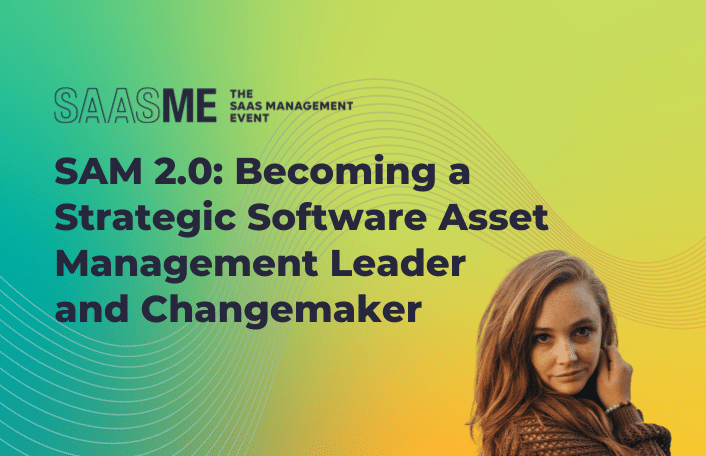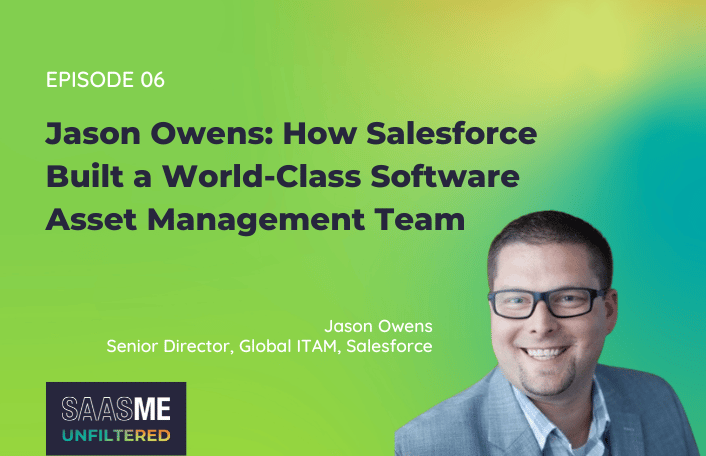
10 Myths About Managing SaaS for Software Asset Management Pros – Debunked
Table of Contents ToggleMyth #1: SaaS Is in the Cloud, So...
Back
Back
Search for Keywords...
Blog

Table of Contents
In the rapidly evolving landscape of software asset management (SAM), the transition from on-premises software to Software as a Service (SaaS) has emerged as a defining paradigm shift. As organizations increasingly embrace cloud-based software delivery models, traditional SAM practices are undergoing a profound transformation.
This shift not only redefines how software is deployed and managed but also fundamentally alters the role of the Software Asset Management leader. The migration to SaaS heralds a new era, where SAM practitioners are not just grappling with compliance and cost optimization, but are also stepping up as strategic leaders and changemakers within their enterprises, empowered to drive significant transformations.
Samantha Griffin, Sr. Manager, Software Asset Management, has seen a lot in her 8+ years at Genesys regarding the change from SAM 1.0 to 2.0.
“We’ve had our fair share of unfortunate situations and audits that have driven additional alignment and executive leadership backing for our program. But through that, we’ve been able to get our hands around our software spend, what’s actually in our environment, how we’re looking to manage what we have, and what’s coming into our ecosystem moving forward,” said Griffin at Zylo’s SaaSMe 2024 event. “It’s been a great journey. I’ve learned a lot and we’re nowhere near finished.”
Rooted in a more traditional approach, SAM 1.0 operates within a structured framework characterized by its process-driven, siloed nature. It primarily focuses on mitigating risks related to audits, ensuring compliance with licensing agreements, and containing costs.
However, this approach often results in rigid procedures and bureaucratic processes, hindering agility and innovation. For example, Griffin explained the focus on compliance can lead to a lack of flexibility in software usage. And that may not align with the evolving needs of the organization.
In contrast, SAM 2.0 represents a departure from the conventional model, embracing a more dynamic and collaborative approach. For instance, SAM practitioners might conduct regular user surveys to understand end users’ unique needs and preferences. They might also collaborate with IT teams to identify and address software usage patterns that could lead to compliance issues. This shift in focus from compliance to user experience and business value is a key aspect of SAM 2.0.
As Griffin notes, “Where we have arrived in the SAM 2.0, at least here at Genesys, is a lot of focus on collaborating on the fly… the communication that you have with your end users is very important, and so is making sure that you’re in the room for all of those conversations.”
The change from SAM 1.0 to SAM 2.0 signifies a profound transformation in software management practices within organizations. Its focus on collaboration cultivates a more inclusive and transparent environment, enabling organizations to respond swiftly to changing business requirements. By engaging stakeholders proactively, SAM 2.0 facilitates the rapid deployment of software solutions tailored to meet evolving needs, enhancing organizational agility and competitiveness in the marketplace.
Genesys Leverages SaaS Management to Further Digital Transformation
See how the leader in cloud customer experience and contact center solutions reinforces software asset management and enterprise architecture with Zylo.
As a Software Asset Management leader, the journey to SAM 2.0 requires a fundamental realignment of executive expectations and perceptions. Building trust with organizational leadership involves a nuanced understanding of their priorities and goals, transcending the traditional focus on cost savings alone.
SAM 1.0 operates within a framework where trust is often established through rigid adherence to compliance standards and the demonstration of cost-saving measures. “In the SAM 1.0… there were a lot of eyes on audit defense and audit readiness, making sure that you were compliant 100% of the time,” explained Griffin.
Meanwhile, SAM 2.0 emphasizes a broader value proposition that extends beyond simple financial considerations. To effectively align executive expectations, it’s crucial to communicate that SAM’s value proposition encompasses strategic elements such as risk mitigation, operational efficiency, and agility. By articulating how SAM initiatives contribute to overarching business objectives and enable innovation, SAM practitioners can foster a deeper sense of trust and collaboration with organizational leadership.
With SAM 2.0, Griffin stressed how bringing everyone on board affects the success of the project. “Moving forward, what we’re looking to do and what we’ve been doing for the past 12 or so months is making sure that we’re not only aligned with senior leadership, but our org-level leaders.”
This shift from a transactional to a strategic approach enhances SAM’s credibility within the organization. It also paves the way for greater alignment between SAM efforts and the enterprise’s overarching goals, enlightening leaders about the transformative potential of SAM 2.0.
Proactive effort is essential for driving meaningful organizational change when tackling SAM 2.0. Rather than waiting for the perfect moment, seize opportunities to demonstrate the immediate impact of SAM initiatives.
In the era of SAM 2.0, establishing a compelling case for your Software Asset Management initiatives is paramount. Crafting a narrative that resonates with stakeholders and aligns with organizational goals is key to garnering support and driving meaningful change.
“Being…a good storyteller is always going to be valuable to [your personal] brand,” shared Griffin.
Stories hold a unique power to convey complex ideas in a memorable way. As SAM practitioners, mastering the art of storytelling allows you to effectively communicate the value of your initiatives to stakeholders across the organization. Craft narratives that illustrate the impact of SAM efforts with tangible outcomes such as cost savings, risk mitigation, and streamlined operational efficiency.
You can engage and inspire stakeholders by weaving together real-world examples and success stories. This fosters a deeper understanding and appreciation for the importance of SAM within the organization. Moreover, storytelling serves as a powerful tool for building a sense of unity and purpose, aligning teams around common goals and objectives, and making everyone feel like part of the SAM 2.0 journey.
Unfortunately, as Samantha Griffin has experienced firsthand, it’s not always easy to sell the value of your work to leadership or management. “Overall, I’ve found there’s a lack of understanding of what software asset management is. And it’s not that people don’t understand the basic functionality of it, but a lot of previous work always went unseen, especially from an executive leadership standpoint.”
Demonstrating that you understand their priorities and concerns can help you forge meaningful relationships with senior leadership. Tailor your communication to resonate with their strategic objectives, positioning SAM as a critical enabler of business success. Engaging with senior leadership thoughtfully and strategically can also help you garner support and advocacy for your SAM initiatives.
Collaboration with the Information Security (Infosec) team is essential for ensuring the integrity and security of SAM processes. Partner with your Infosec counterparts to align SAM practices with cybersecurity best practices. These may include leveraging multi-factor authentication (MFA), single sign-on (SSO), and other robust security measures to safeguard software assets against threats.
As technology evolves, staying informed about emerging trends and potential risks is essential. Educate yourself on artificial intelligence (AI) and its implications for SAM practices. Understand how AI-driven solutions can enhance SAM capabilities while also mitigating associated risks such as data privacy and security concerns.
By embracing these strategies, SAM practitioners can cultivate a compelling brand for SAM 2.0 that resonates with stakeholders, drives meaningful change, and fosters a culture of innovation and excellence within the organization. Become the Software Asset Management leader your organization needs to keep up with the changing needs of today’s software landscape.
Discover how Zylo can empower you and your organization to harness the full potential of Software Asset Management 2.0. With Zylo’s innovative platform, you can gain greater visibility and control over your SaaS ecosystem, driving efficiency, compliance, and cost savings. Start your journey to SAM 2.0 today with Zylo’s comprehensive platform and unlock the strategic advantages of effective software management.
Watch Samantha Griffin’s full session from SaaSMe 2024 here.

Table of Contents ToggleMyth #1: SaaS Is in the Cloud, So...

Table of Contents ToggleEpisode SummaryGuest SpotlightEpisode HighlightsCreate a Program that Pays...

Table of Contents ToggleQuestion #1: How many SaaS applications do we...

Table of Contents ToggleNASA Software Audit Lesson #1: Visibility Must Be...
| Cookie | Duration | Description |
|---|---|---|
| cookielawinfo-checkbox-analytics | 11 months | This cookie is set by GDPR Cookie Consent plugin. The cookie is used to store the user consent for the cookies in the category "Analytics". |
| cookielawinfo-checkbox-functional | 11 months | The cookie is set by GDPR cookie consent to record the user consent for the cookies in the category "Functional". |
| cookielawinfo-checkbox-necessary | 11 months | This cookie is set by GDPR Cookie Consent plugin. The cookies is used to store the user consent for the cookies in the category "Necessary". |
| cookielawinfo-checkbox-others | 11 months | This cookie is set by GDPR Cookie Consent plugin. The cookie is used to store the user consent for the cookies in the category "Other. |
| cookielawinfo-checkbox-performance | 11 months | This cookie is set by GDPR Cookie Consent plugin. The cookie is used to store the user consent for the cookies in the category "Performance". |
| viewed_cookie_policy | 11 months | The cookie is set by the GDPR Cookie Consent plugin and is used to store whether or not user has consented to the use of cookies. It does not store any personal data. |
